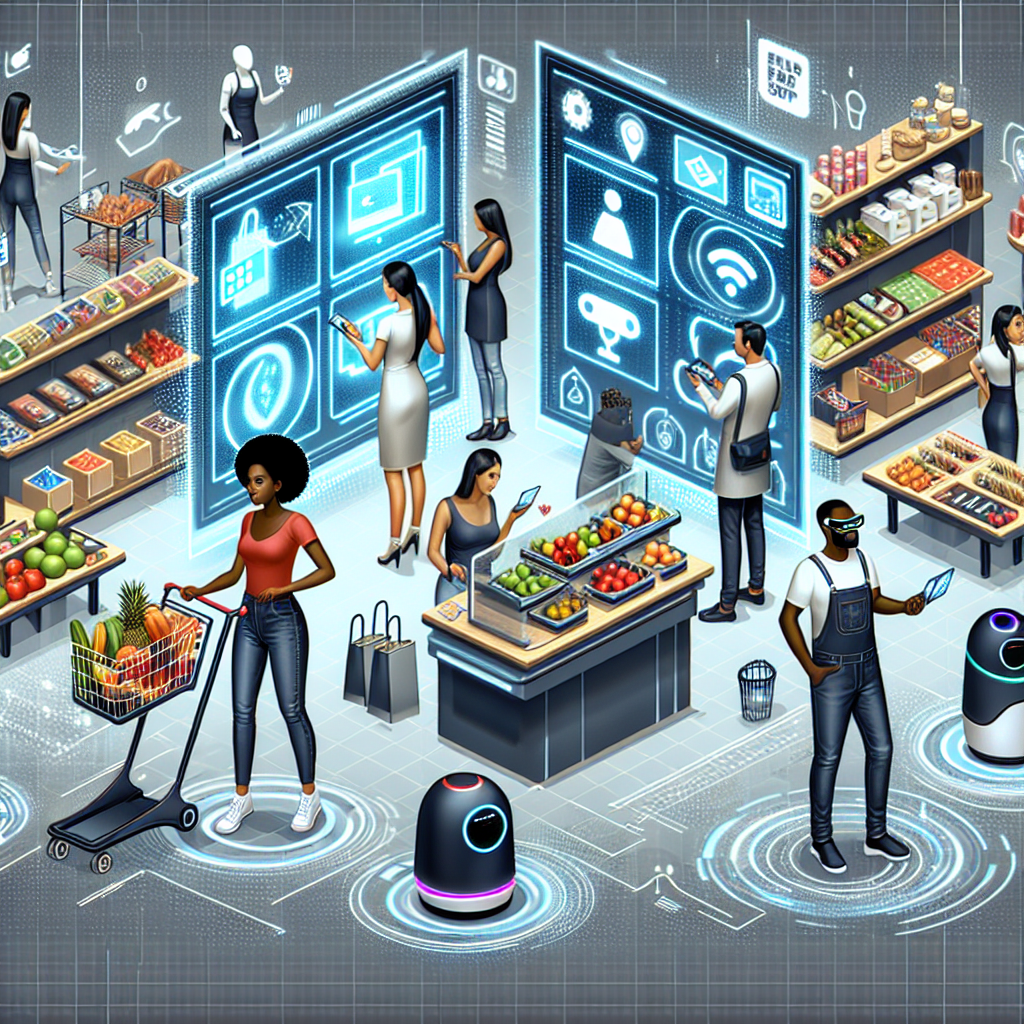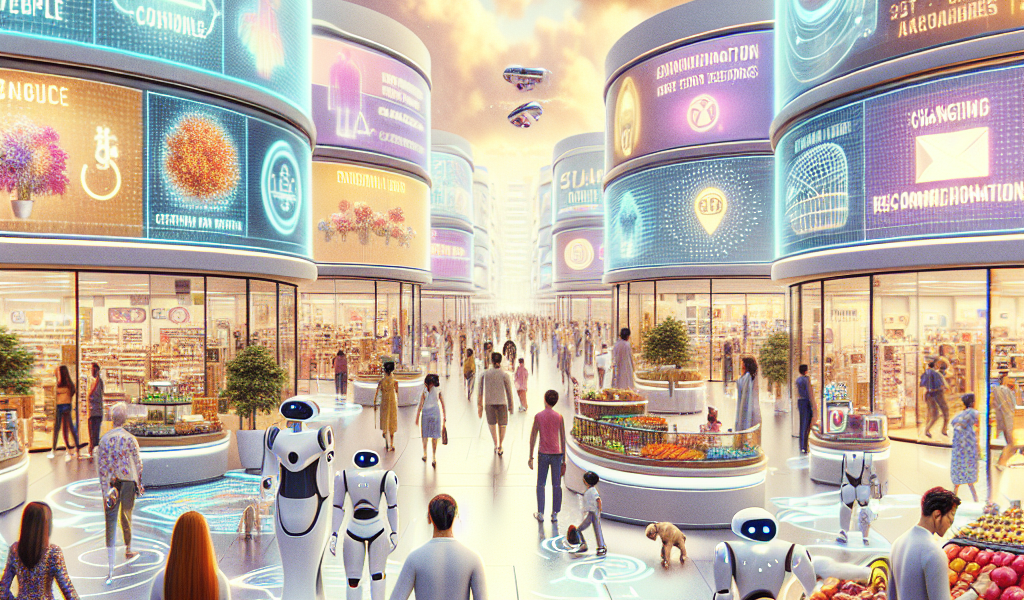-
Table of Contents
“Revolutionizing Shopping: The Future of Smart Retail Technology”
Introduction

The Future of Smart Retail Technology
The retail industry is undergoing a transformative shift driven by rapid advancements in smart technology. As consumer expectations evolve and competition intensifies, retailers are increasingly leveraging innovative solutions to enhance the shopping experience, streamline operations, and gain a competitive edge. The future of smart retail technology promises a landscape where artificial intelligence, the Internet of Things (IoT), augmented reality, and data analytics converge to create highly personalized, efficient, and immersive retail environments. This evolution is set to redefine how consumers interact with brands, make purchasing decisions, and experience shopping both online and in physical stores. As we look ahead, the integration of these cutting-edge technologies will not only revolutionize the retail sector but also set new standards for customer engagement and operational excellence.
Revolutionizing Customer Experience with AI-Powered Personalization
The retail landscape is undergoing a seismic shift, driven by the rapid advancements in artificial intelligence (AI) and machine learning technologies. As consumers increasingly demand personalized experiences, retailers are turning to AI-powered solutions to meet these expectations and revolutionize the customer experience. This transformation is not just a trend but a fundamental change in how businesses interact with their customers, offering a glimpse into the future of smart retail technology.
One of the most significant ways AI is reshaping retail is through personalized recommendations. By analyzing vast amounts of data, AI algorithms can predict consumer preferences with remarkable accuracy. This capability allows retailers to offer tailored product suggestions, enhancing the shopping experience and increasing the likelihood of purchase. For instance, online giants like Amazon and Netflix have long utilized AI to recommend products and content, setting a high bar for personalization that other retailers are now striving to meet.
Moreover, AI-powered chatbots and virtual assistants are becoming indispensable tools for customer service. These intelligent systems can handle a wide range of inquiries, from answering product questions to assisting with returns, all while providing a seamless and efficient experience. By leveraging natural language processing, these chatbots can understand and respond to customer queries in real-time, offering a level of convenience that was previously unattainable. This not only improves customer satisfaction but also frees up human employees to focus on more complex tasks.
In addition to enhancing customer service, AI is also transforming the in-store experience. Retailers are increasingly deploying smart shelves and digital displays that can interact with customers in real-time. These technologies use sensors and cameras to gather data on shopper behavior, allowing for dynamic pricing and personalized promotions. For example, a smart shelf might recognize a frequent shopper and offer them a discount on their favorite brand, creating a more engaging and rewarding shopping experience.
Furthermore, AI is playing a crucial role in inventory management and supply chain optimization. By predicting demand patterns and identifying potential disruptions, AI can help retailers maintain optimal stock levels and reduce waste. This not only ensures that customers can always find the products they need but also contributes to more sustainable business practices. Retailers like Walmart and Zara are already leveraging AI to streamline their supply chains, resulting in faster restocking and improved product availability.
As we look to the future, the integration of AI with other emerging technologies such as augmented reality (AR) and the Internet of Things (IoT) promises to take personalization to new heights. Imagine walking into a store where AR glasses provide you with personalized product information and recommendations based on your past purchases and preferences. Or consider a smart home device that automatically reorders household items when supplies run low, ensuring you never run out of essentials.
While the potential of AI-powered personalization is immense, it is not without its challenges. Privacy concerns and data security are paramount, as retailers must navigate the fine line between offering personalized experiences and respecting customer privacy. Transparent data practices and robust security measures will be essential in building and maintaining consumer trust.
In conclusion, AI-powered personalization is revolutionizing the retail industry, offering unprecedented levels of convenience and engagement for consumers. As technology continues to evolve, the possibilities for enhancing the customer experience are virtually limitless. Retailers that embrace these innovations will be well-positioned to thrive in the competitive landscape, delivering the personalized experiences that today’s consumers crave.
The Role of IoT in Enhancing Retail Supply Chain Efficiency
The retail industry is undergoing a seismic shift, driven by the rapid advancement of technology. Among the most transformative innovations is the Internet of Things (IoT), which is revolutionizing the way retailers manage their supply chains. As the backbone of retail operations, the supply chain’s efficiency directly impacts everything from inventory management to customer satisfaction. IoT, with its interconnected network of devices, sensors, and systems, is poised to enhance this efficiency in unprecedented ways.
To begin with, IoT enables real-time tracking and monitoring of goods throughout the supply chain. This capability is crucial for retailers who need to ensure that products are available when and where customers want them. By embedding sensors in shipping containers, pallets, and even individual products, retailers can gain instant visibility into the location and condition of their inventory. This real-time data allows for more accurate forecasting and demand planning, reducing the risk of stockouts or overstock situations. Consequently, retailers can maintain optimal inventory levels, which not only cuts costs but also improves customer satisfaction by ensuring that popular items are always in stock.
Moreover, IoT technology facilitates predictive maintenance of equipment used in the supply chain. For instance, sensors can monitor the health of machinery in warehouses and distribution centers, alerting managers to potential issues before they lead to costly breakdowns. This proactive approach minimizes downtime and keeps the supply chain running smoothly. Additionally, IoT can optimize the performance of delivery vehicles by monitoring factors such as fuel consumption, engine health, and driver behavior. This data can be used to schedule timely maintenance, plan more efficient routes, and even train drivers to adopt safer and more fuel-efficient driving practices.
Another significant advantage of IoT in the retail supply chain is its ability to enhance transparency and traceability. Consumers today are increasingly concerned about the origins and ethical sourcing of the products they purchase. IoT can provide detailed information about a product’s journey from the manufacturer to the store shelf. By scanning a QR code or using a mobile app, customers can access data about where and how a product was made, its environmental impact, and its journey through the supply chain. This level of transparency not only builds trust with consumers but also helps retailers comply with regulatory requirements and industry standards.
Furthermore, IoT can streamline warehouse operations through automation and smart inventory management. Automated guided vehicles (AGVs) and robotic systems, powered by IoT, can handle tasks such as picking, packing, and sorting with greater speed and accuracy than human workers. These systems can work around the clock, increasing productivity and reducing labor costs. Additionally, smart shelves equipped with weight sensors can monitor stock levels in real-time and automatically trigger reorders when inventory runs low. This ensures that warehouses are always stocked with the right products, ready to meet customer demand.
In conclusion, the integration of IoT into the retail supply chain offers a multitude of benefits that enhance efficiency, reduce costs, and improve customer satisfaction. By providing real-time visibility, enabling predictive maintenance, enhancing transparency, and automating warehouse operations, IoT is transforming the way retailers manage their supply chains. As technology continues to evolve, the role of IoT in retail will only become more significant, paving the way for a smarter, more efficient future in the industry.
Augmented Reality: Transforming In-Store Shopping Experiences
As the retail landscape continues to evolve, augmented reality (AR) is emerging as a transformative force, reshaping the in-store shopping experience in ways previously unimaginable. This cutting-edge technology is not only enhancing customer engagement but also providing retailers with innovative tools to drive sales and improve operational efficiency. By seamlessly blending the physical and digital worlds, AR is creating immersive shopping environments that captivate consumers and offer unprecedented levels of convenience.
One of the most compelling applications of AR in retail is the virtual try-on feature. This technology allows customers to visualize how products will look on them without the need to physically try them on. For instance, beauty brands have introduced AR mirrors that enable shoppers to experiment with different makeup shades and styles in real-time. Similarly, fashion retailers are leveraging AR to let customers see how clothing items fit and look on their bodies, reducing the need for fitting rooms and minimizing the hassle of returns. This not only enhances the shopping experience but also helps retailers manage inventory more effectively.
Moreover, AR is revolutionizing product information delivery. Traditional product tags and labels are being replaced by interactive AR displays that provide detailed information about the product, including its features, benefits, and even customer reviews. Shoppers can simply point their smartphones at a product to access this wealth of information, making informed purchasing decisions easier than ever. This level of transparency builds trust and fosters a deeper connection between the brand and the consumer.
In addition to enhancing the customer experience, AR is also proving to be a valuable tool for retailers in terms of store layout and design. By using AR, retailers can visualize different store configurations and optimize the placement of products to maximize foot traffic and sales. This technology allows for real-time adjustments and experimentation without the need for physical changes, saving both time and resources. Furthermore, AR can assist in training staff by providing interactive simulations and scenarios, ensuring that employees are well-prepared to assist customers and operate efficiently.
The integration of AR into loyalty programs is another exciting development. Retailers are using AR to gamify the shopping experience, encouraging customers to engage with the brand in new and exciting ways. For example, some stores have introduced AR treasure hunts, where customers can use their smartphones to find hidden virtual items within the store. These interactive experiences not only make shopping more enjoyable but also drive repeat visits and foster brand loyalty.
While the benefits of AR in retail are clear, it is important to acknowledge the challenges that come with its implementation. High development costs and the need for specialized hardware can be barriers for some retailers. Additionally, ensuring a seamless and intuitive user experience is crucial, as any technical glitches or complexities can deter customers from using the technology. However, as AR technology continues to advance and become more accessible, these challenges are likely to diminish.
In conclusion, augmented reality is poised to revolutionize the in-store shopping experience, offering a blend of convenience, engagement, and efficiency that benefits both consumers and retailers. By embracing AR, retailers can create dynamic and interactive environments that not only attract customers but also keep them coming back. As this technology continues to evolve, it will undoubtedly play a pivotal role in shaping the future of smart retail, making shopping more personalized, informative, and enjoyable than ever before.
Conclusion
The future of smart retail technology is poised to revolutionize the shopping experience through the integration of advanced technologies such as artificial intelligence, machine learning, Internet of Things (IoT), and augmented reality. These innovations will enable highly personalized customer experiences, optimize inventory management, and streamline operations. Retailers will benefit from enhanced data analytics, allowing for better decision-making and targeted marketing strategies. As technology continues to evolve, the retail landscape will become increasingly automated and efficient, ultimately leading to greater customer satisfaction and business growth.





